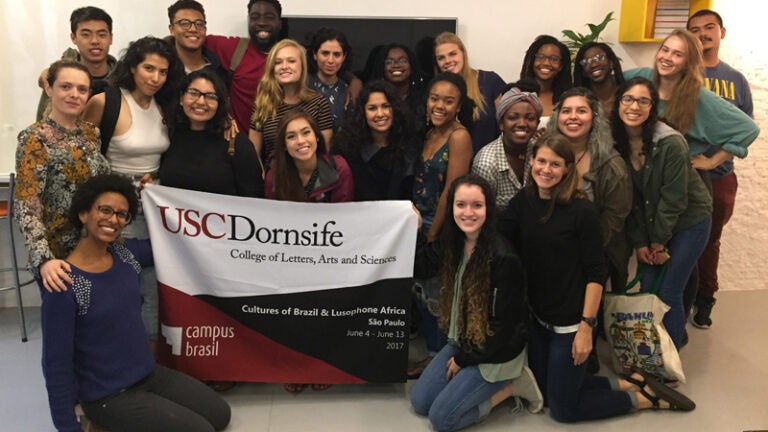
Students see, taste and smell the culture of Brazil
In the 15th century, Portuguese explorers set sail south across the Atlantic Ocean fueled by a quest for spices and gold. Their expeditions planted the seeds of an empire that at its height extended from Europe to territories in the Americas, Africa and Asia.
Bookending the southern Atlantic Ocean, the Portuguese established colonies in Brazil and the African countries of Angola, Cape Verde, Guinea-Bissau, Mozambique, and the island nation of São Tomé and Príncipe. Culture flowed between those geographically parallel regions, particularly through the export of slave labor from Africa to Brazil.
This summer, students from USC Dornsife traveled to Brazil to learn about its shared history with Portuguese-speaking Africa by immersing themselves in Brazil’s language, literature, religion, arts and food in the Maymester course, “Cultures of Brazil and Lusophone Africa” (PORT-250g). Maymester courses are month-long, four-unit classes that take place after Commencement and focus on off-campus experiential learning.
“Culture is hard to understand just by reading about it,” said Ellen Oliveira, assistant professor (teaching) of Spanish and Portuguese, who led the course. “I wanted students to live the culture — to see it, taste it, smell it. To experience everyday life rather than sit in a classroom and talk about it.”
In the heart of Afro-Brazilian culture
The students began their journey in Salvador, Brazil’s first capital under Portuguese rule.
Serving as a slave port in the colonial era, Salvador has a heavy African influence and is a center of Afro-Brazilian culture. Slaves from Africa brought their traditions, including the Candomblé religion, which is still part of the fabric of Salvador today.

SLIDESHOW: Click the photo above to follow the class’ adventures in Brazil. Photos courtesy of Jazmin Lopez and Ellen Oliveira.
Candomblé is a polytheistic religion passed down as an oral tradition without holy scriptures. Practitioners believe in a supreme creator who is served by deities called orishas. Each religious follower is also believed to have their own protector orisha.
During the time of the slave trade, slave owners tried to convert their slaves to Catholicism, and throughout the years Candomblé followers practiced their religion in secret to escape persecution. Students visited two Candomblé temples in the city and spoke with one of the church mothers to learn more about the religion’s significance.
Psychology major Jazmin Lopez was inspired by the exchange. “[The church mother] spoke to us about her experience in the religion and how practicing her religion is an act of resistance,” Lopez said. “We learned that regardless of how much time has passed there are still a lot of issues going on with religious persecution.” Candomblé practices have been denounced by other religious faiths in Brazil, and some practitioners of the religion have been the targets of hate crimes.
Students also toured the city and took classes in Brazilian cooking and capoeira, a style of martial arts that combines acrobatics, music and dance. They studied Brazilian music, attended the Balé Folclórico da Bahia, a troupe that performs folk dances of African origin, and took a walking tour of Salvador street art with artist Eder Muniz, whose vibrant murals color the streets of Salvador. Muniz, who co-founded an artist collective to encourage creativity in the city’s favelas, or shantytowns, was appointed by the mayor to lead the Salvador Graffiti Project, which empowers artists to transform the city’s common spaces with art and positive social messages.
The students further embraced their goals to experience Brazil as locals do by foregoing hotels and instead staying with host families in Salvador. Lopez had studied Portuguese for a year at USC Dornsife prior to the trip, but living with a host family ramped up her fluency.
“My Portuguese was so much better toward the end of the trip,” she said, “because we were actually living, breathing and sleeping Brazilian Portuguese.”
Tracing the Brazilian Dream
For the second leg of their tour in Brazil, the class travelled to São Paulo, one of the world’s most populous cities. Among the skyscrapers, monuments, museums and parks, Oliveira wanted to help students understand the Brazilian Dream.
“São Paulo is the place where people go when they’re trying for a better life,” she explained. “Here students can see a more contemporary, more diverse Brazil. It’s a place where you have people of different nationalities and from all different cultures that come together and become one.”
Students explored different neighborhoods including downtown São Paulo and the Japanese district, which is home to the largest Japanese population outside of Japan. They also visited the Immigration Museum and Abraço Cultural, a nongovernmental organization that supports refugees through cultural exchange.
Lopez is interested in pursuing a career working with at-risk youth. Visiting Abraço Cultural and the Steve Biko Institute, a nonprofit in Salvador that works with black students to achieve higher education, helped solidify her professional goals.
“I have been thinking about getting my Ph.D. in clinical psychology, volunteering at a nonprofit and becoming a therapist,” Lopez said. “But seeing people work for different nonprofits in Brazil showed me that I can make a career out of it. And I could even work in another country and make an impact.”